A Brief History of PM Tools on Apple Mac
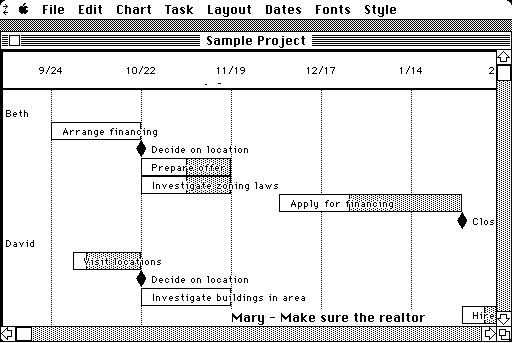
I found my professional passion in project management: I love approaching new challenges, building teams and taking projects from the initial idea to go-live. Inevitably I permanently look for tools and methods to make work easier for me and my teams. As both historically and contemporary the nicest releases in PM software were made for Mac, I wrote a brief history about it which also includes some milestones of Apple.
Table of contents
Origins of computing
Personal Computer
The pioneer of PM software
Development of MacProject
A PM software facilitator
Copycat: Microsoft‘s PM-Tool
Independent players in the PM software market
Operating system market consolidation
The Mac PM software market
Different directions
A new generation of project management applications
Origins of computing
From my point of view, one of the origins of today’s computing can be found in UK’s and America’s textile industry in the 18th and 19th century. Punched tapes were used to control weaving looms. Based on the information on the punched tapes, yarns in different colors were shot through the loom – or not. Larger 0/1 chains of events were built which ended in an automated process to create patters in the cloth. The very same principle was then for example used for hurdy-gurdys and pianolas to play music. By the end of the 19th century punched tapes were introduced into US administration for data processing tasks. Information could be written onto and read from punched tape.
Personal Computer
In the 1940s machines could perform calculations based on punched tape. Government administrations, agencies, universities and enterprises began using complex machines. In the 1960s those machines already had displays and typewriter-like-keyboards. In 1976 Apple started selling computers for home use. Shortly afterwards Xerox introduced a graphical user interface to several products. Apple realized the potential of that new approach in a world that only knew command lines – and licensed Xerox idea. They also saw the brand-new “mouse” device from Sun Microsystems and incorporated all that into something entirely new to the market: Apple Lisa, which was designed with the plan to convince business target groups.
The pioneer of PM software
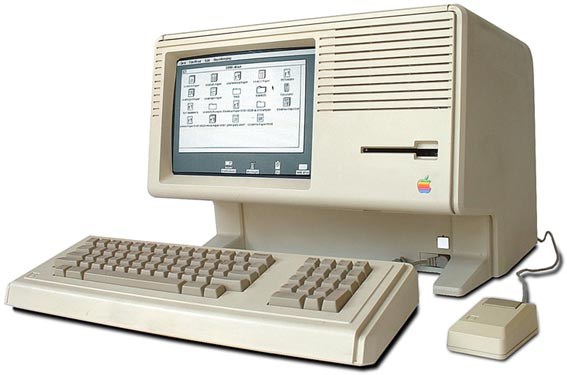
When Apple released information on the product development of Lisa, it caught the attention of HP’s Debra Wilrett. She was annoyed by problems in the planning of projects. She realized that Lisa might give her the opportunity to do something about it and solve a lot of those problems by using a graphical user interface. She pitched her idea to Apple’s marketing department and she succeeded: Apple saw the business advantage of her idea, gave her a contract and a first prototype of Lisa, so she could start working. Debra became an entrepreneur, started her own company and developing “Lisa Project”. Apple Lisa was released in early 1983 and “Lisa Project” was available from the beginning.
“Lisa Project” was the first project management application with a graphical user interface. The main use was the interactive creation of a PERT-chart (Program Evaluation and Review Technique). It was possible to visualize orders, relations and dependencies of work packages and deliverables – which made it more comprehensible for everyone involved. Now you could see when each work package was due and which work packages depend on it. You could also dynamically create critical path, scheduling, resource and budget planning – and visualize the results in Gantt charts. “Lisa Project” even convinced NASA which became the biggest customer of the software.
Development of MacProject
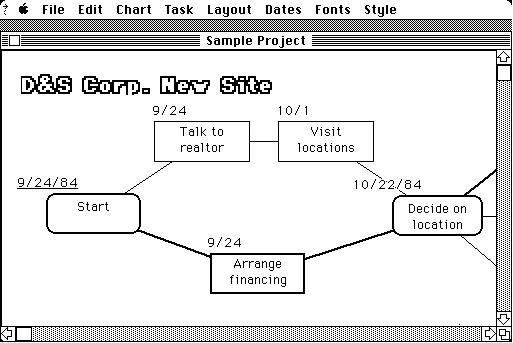
Apple Lisa was not successful with its business target groups and did not become a commercial success – so it was terminated in 1986. Apple already changed their strategy in 1983 and tried to introduce a cheaper version of Lisa for home use. They developed the Apple Macintosh which was released in early 1984. For the first time, there was a new kind of personal computer on the market that featured a mouse, keyboard, display and graphical user interface – instead of command lines – remaining loyal to the Motorola system architecture.
Apple started targeting business people for the Macintosh as well and tried to catch their attention with Super Bowl commercials. Therefore, they needed business software. Apple asked Debra Wilrett to develop a version of her software for Macintosh. Debra followed their request and “Lisa Project” became “MacProject”.
In 1987 Apple founded a spin-off: Claris which integrated all business applications for Macintosh – of course, it included MacProject.
A PM software facilitator
In the 1980s James Halcomb was one of the most known expert for the critical path method. This method was used synonymously for project management for a long time. He used Lisa Project and he was excited about it. As affordable Macs became available he started using them in his seminars and trainings. He wrote the book “Planning Big with MacProject” which became one of the bestselling books for Mac software. The book introduced mainly the critical chain method and MacProject to his readers. This lead to MacProject becoming THE standard tool for project management in the late 1980s.
Copycat: Microsoft‘s PM-Tool
It became buried in oblivion that Microsoft used to develop software for Apple Macintosh. Microsoft Project was already released in 1984 – based on MS-DOS with a command line user interface. Compared with MS Project Mac Projects was way more elegant and helpful. In 1990 Microsoft released the first version for the new Windows operating system – which introduced a graphical user interface on Microsoft operating systems. In 1991, they ported MS Project to the Macintosh and immediately became the greatest competitor for Mac Project – which was developed until 1993.
Independent players in the PM software market
In 1987 AEC Software released a new application onto the PM software market: FastTrack Schedule. Unlike its big competitors Claris and Microsoft – AEC was a very small company. The succeeded in finding their market niche for their software and stand their ground in the market. They translated their application into six more languages and added more functions that the other applications at that time lacked: Collaboration of users on a joint plan, portfolio management, workflows and reporting. The software was released for Apple and Microsoft operating systems – and the files were even compatible for use on both platforms. Project managers with Windows and project managers with Apple equipment could work together on the same files for the first time.
Over the years, more and more players introduced their project management software onto the market. By the middle of the 1990s there were already about 30 different products available.
Operating system market consolidation
In the 1980s there was a vast variety of platforms and operating systems. Beneath Apple and Microsoft also DEC and IBM were huge on the market. Also, there were a couple of different technical system architectures.
Microsoft developed their own unix-derivative called Xenix in the segment of IBM-compatible architectures. Though Microsoft lost interest in Xenix, they stayed loyal to the IBM-architectures and developed MS-DOS as their new operating system. As a visual frontend for MS-DOS they introduced Windows in 1985.
Since the late 1980s IBM-architecture succeeded in business environments and Microsoft started their triumph in the business segment. IBM tried to convince customers with their own OS/2 operating system and realized some notable innovations (e.g. 32-Bit-Architecture, Multi-Tasking), which were used by several other manufacturers – but never made it to significant market shares.
In the 1990s there were several different application suites competing in the business office market. Besides Microsoft Office there were also Corel Wordperfect Suite, Lotus Smartsuite (Lotus was later acquired by IBM) and Star Office. Microsoft reached a market share of more than 80% by the middle of the 1990s.
Meanwhile in the Apple universe: Claris and their office suite Claris Works became Filemaker. The suite was transferred back to Apple and continued as AppleWorks. Apple restricted its suite to the Macintosh– while the other manufacturers also published their suites on the Macintosh. The market shares of most manufacturers were shrinking even further. In the early 2000s the market variety for business applications had vanished.
The Mac PM software market
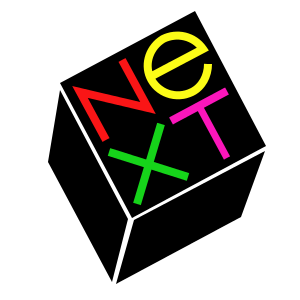
In the 1990s Apple had the major problem, that their MacOS was technically outdated and far from sustainable – while their hardware was selling well. Their approach to solve that problem was the acquisition of the company NeXT in late 1996. Led by Steve Jobs, NeXT had developed a unix-based operating system that lead the way at that time – but had hardware that did not keep up with the level of the OS – and also did not sell well.
Steve Jobs made sure that Apple moved on to a new sustainable operating system, that was basically on NeXTstep. This would become MacOS X.
This change had a major impact for the compatibility of the available software. The existing software did no longer run on the new operating system and had to be ported or rewritten. Many software manufacturers, especially the smaller ones did not want to spend this amount of effort in the eye of unclear vending success. Suddenly there was only one project management software application left for Mac: FastTrack Schedule.
Different directions
Apple released products based on IBM-architectures, such as the PowerPC, but it lost the business segment totally. Apple became maker for consumers and creative crowd, such as photographers, designers and musicians. Microsoft managed to dominate the business segment while being successful in the consumer segment – but Microsoft relaxed on the advantage that their users already knew their software from work.
Meanwhile in the Apple universe, Apple tried to focus on the convenience and ease of use, nowadays called usability. Not only with their software, but also with their other products. They were able to transform this into a major competitive advantage.
A new generation of project management applications
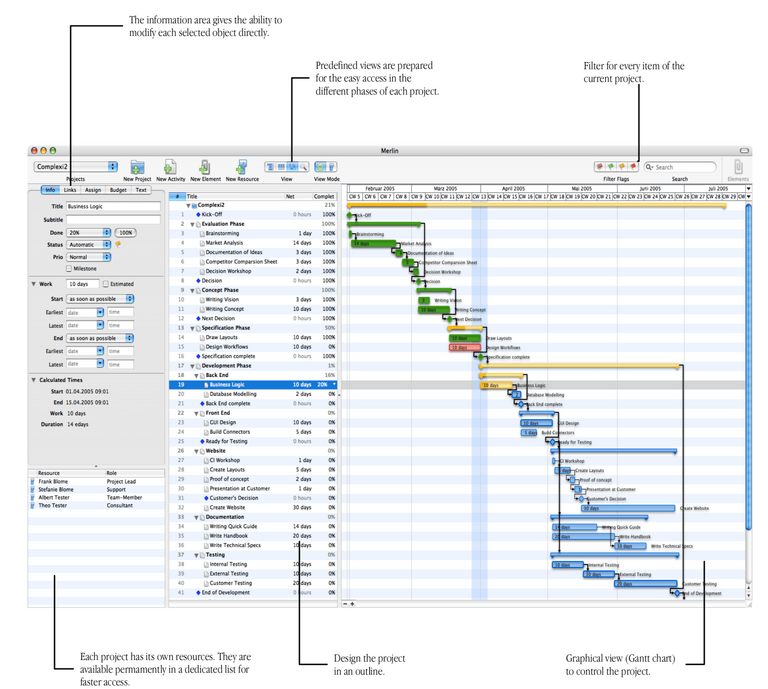
Merlin Version 1, released in 2004
Meanwhile in Germany: In 2004 the small ProjectWizards team developed a brand new project management application for Mac. The team was convinced of their MacBooks and brought them to work into the business world. They wanted to work as intuitively in their jobs as they did at home. They needed a great project management tool – but there weren’t any left on the market.
ProjectWizards developed their own smart solution for planning projects with an attractive graphical interface: Merlin. As great project management software on the Mac was hard to find – the tool became quite successful shortly after its release.
Following the Mac strategy, ProjectWizards focusses on their customers for their product improvements. Over the years they renamed their product from Merlin to Merlin Project. Merlin has a great collection of features while user-friendliness and clarity were optimized.
Merlin Project remains one of the leading applications for project management on the Mac. While using MS Project is purposeful, but quite an ordeal as it isn’t intuitive at all – Merlin project convinces me with their features, design and intuitiveness. In all decisions they do for development, ProjectWizards aim is to provide the best PM software for Mac.
The author
Harald works as a project portfolio manager in an enterprise environment. He is passionate about new endeavours and technologies. He helps teams become more effective and bring ideas to life and to their go-live. More from Harald on zauberwerk.com.

